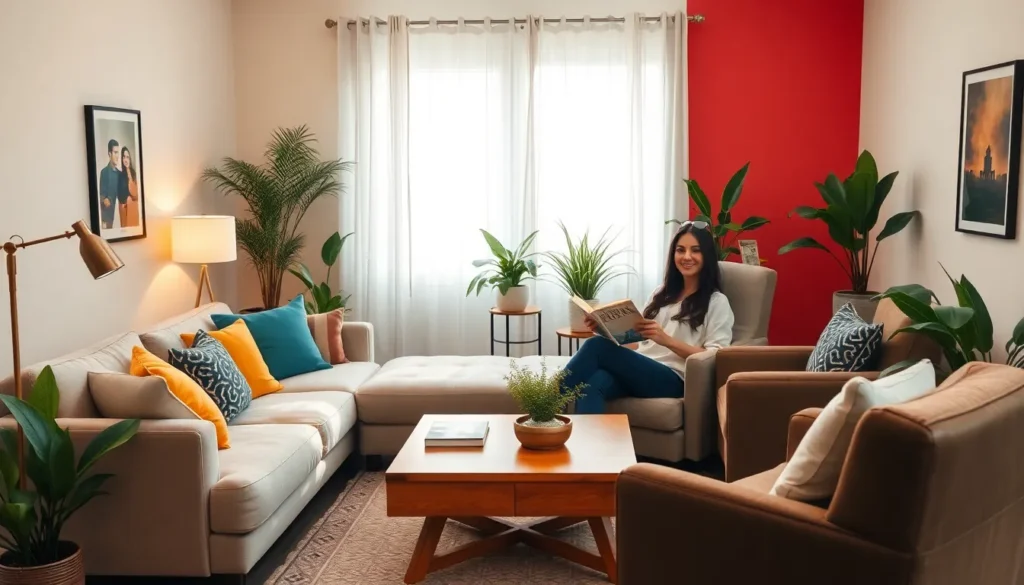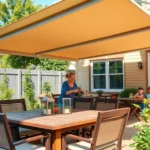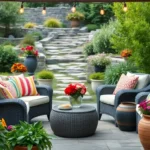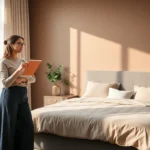Your living room serves as the heart of your home where family gatherings unfold and memories take shape. Whether you’re starting from scratch or looking to refresh your existing space we understand that creating the perfect living room can feel overwhelming with endless design possibilities.
We’ve curated the most inspiring and practical living room ideas that’ll transform your space into a stunning sanctuary. From budget-friendly makeovers to luxurious renovations these proven strategies will help you maximize both style and functionality in your most-used room.
Ready to discover how small changes can make a massive impact? We’ll show you exactly how to blend comfort with elegance while reflecting your unique personality through thoughtful design choices that won’t expensive.
Create a Cozy Reading Nook in Your Living Room
Transform an unused corner into your personal sanctuary with a dedicated reading space. We’ll show you how to design the perfect spot for escaping into your favorite books without major renovations.
Choose the Perfect Corner Location
Corner spaces near windows provide natural light and create intimate boundaries for your reading retreat. We recommend selecting spots that receive morning or afternoon sunlight but avoid direct harsh rays that create glare on book pages. Areas adjacent to built-in bookshelves or entertainment centers offer convenient storage for your current reads and reading accessories.
Traffic flow matters when positioning your nook, so we suggest avoiding high-traffic pathways between rooms or near the main seating area. Quiet corners away from television viewing angles help maintain focus during reading sessions. Consider alcoves under staircases, bay window areas, or unused spaces behind sofas as potential locations.
Temperature control affects reading comfort, which means avoiding spots near heating vents or drafty windows. We find corners that maintain consistent room temperature throughout the day work best for extended reading periods.
Select Comfortable Seating Options
Armchairs with proper back support accommodate various reading positions while providing comfort for long sessions. We recommend chairs with arms wide enough to rest books or tablets, plus cushions that maintain their shape over time. Ergonomic designs that support your natural posture prevent neck strain and back discomfort.
Reading chairs should fit your body proportions, with seat depth allowing your back to touch the backrest while keeping feet flat on the floor. We suggest testing chairs in person when possible, paying attention to cushion firmness and arm height relative to your reading materials.
Alternative seating options include window seats with added cushions, small loveseats, or even floor cushions for casual reading styles. Bean bags work well for younger readers or those who prefer flexible positioning options.
Add Proper Lighting for Reading
Task lighting eliminates eye strain and extends comfortable reading time beyond daylight hours. We recommend floor lamps with adjustable necks that direct light over your shoulder onto book pages without casting shadows. LED bulbs between 2700K and 3000K provide warm, comfortable illumination that won’t cause headaches.
Table lamps positioned at shoulder height offer focused lighting while maintaining ambient room atmosphere. We suggest lamps with swing-arm features or adjustable shades that let you customize light direction based on seating position and time of day.
Natural light enhancement comes from sheer curtains or adjustable blinds that filter harsh sunlight while maintaining brightness. Wall sconces mounted beside reading chairs save floor space while providing dedicated task lighting for your nook area.
Maximize Small Living Room Spaces with Smart Furniture
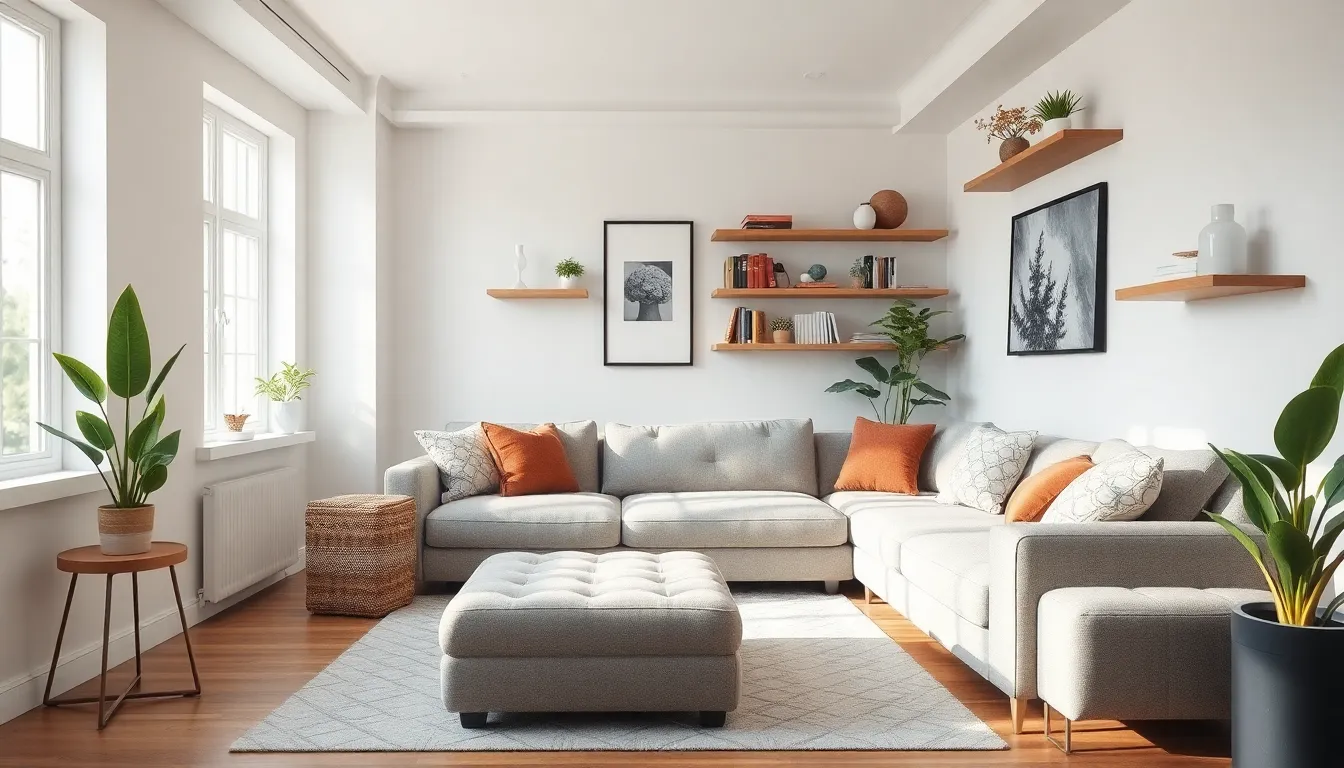
When we’re working with limited square footage, choosing the right furniture pieces can transform our compact living room into a functional and stylish space. Smart furniture selections help us make the most of every inch while maintaining comfort and aesthetic appeal.
Use Multi-Functional Storage Ottomans
Multi-functional storage ottomans serve dual purposes as both seating and hidden storage answers in our small living rooms. We can store blankets, books, electronics, and other essentials inside these versatile pieces while using them as extra seating for guests or footrests during movie nights. Storage ottomans help us declutter our space by reducing visual noise, which creates an increased sense of openness in compact areas. Choosing ottomans with removable tops gives us easy access to stored items, while selecting ones with sturdy construction ensures they’ll support weight as seating options. We recommend positioning these pieces strategically near our main seating area for maximum functionality.
Install Floating Shelves for Vertical Storage
Floating shelves maximize our vertical wall space while keeping floor areas clear and uncluttered. We can display books, decorative items, plants, and daily essentials on these shelves without encroaching on our limited seating or circulation areas. Installing floating shelves takes advantage of unused wall space above furniture pieces like sofas or side tables. Interior designers recommend this approach because it draws the eye upward, making rooms feel larger and more open. We should select shelves that complement our existing decor style and arrange items in groups of odd numbers for visual appeal. Mounting shelves at varying heights creates visual interest while providing different storage zones for various items.
Choose Space-Saving Sectional Sofas
Space-saving sectional sofas anchor our living room while providing ample seating without overcrowding the space. We can select well-proportioned sectionals designed specifically for small rooms to optimize seating capacity while maintaining an open flow throughout the area. Design experts suggest using a large sectional as our primary anchor piece and limiting additional seating to avoid creating a cramped feeling. Sectionals help us streamline our layout by combining multiple seating functions into one cohesive piece of furniture. We should measure our space carefully before purchasing to ensure the sectional fits comfortably while leaving adequate walkways. Corner sectionals work particularly well in small rooms because they use space efficiently while creating a natural conversation area.
| Strategy | Purpose/Effect | Example Implementation |
|---|---|---|
| Multi-functional storage ottoman | Seating + hidden storage | Store blankets, electronics |
| Floating shelves | Vertical storage, less floor clutter | Hold books, decor |
| Space-saving sectional sofa | Maximize seating, streamline layout | Anchor piece for small rooms |
Transform Your Living Room with Bold Accent Walls
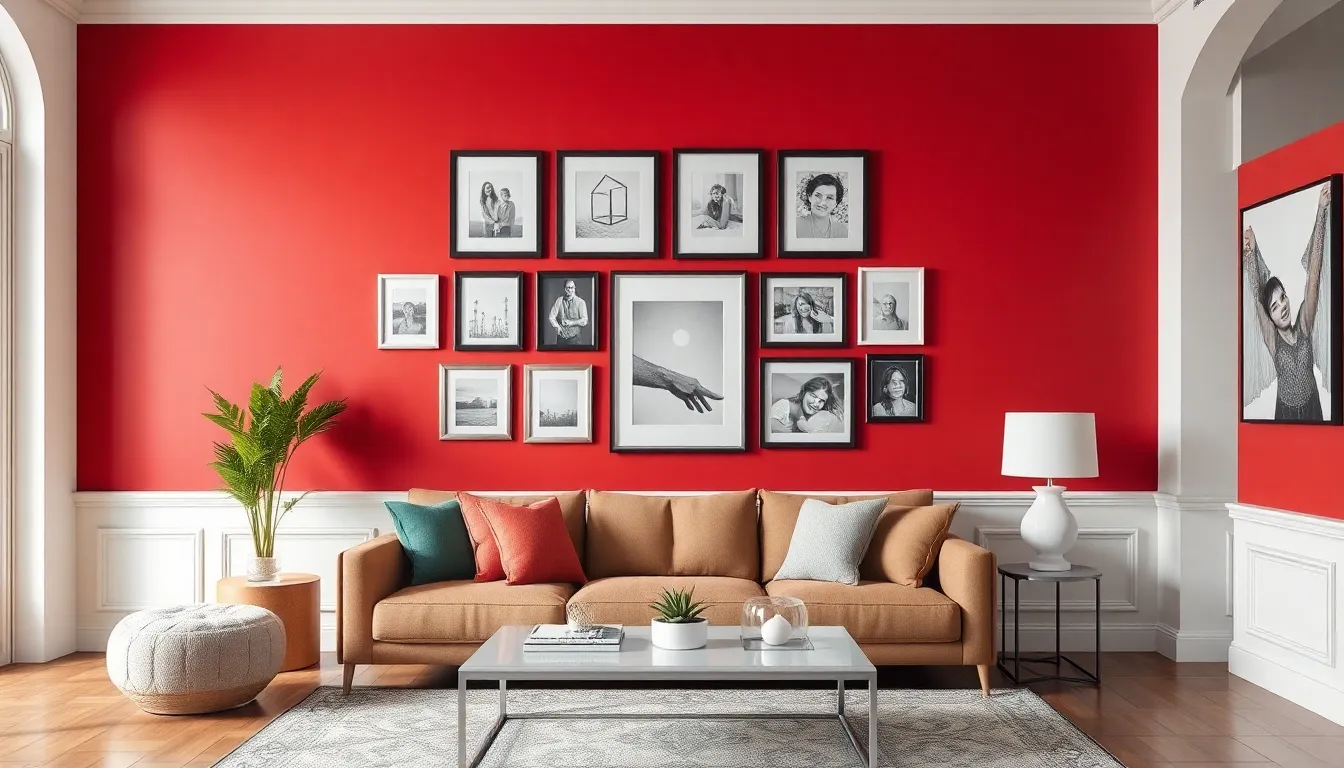
Accent walls serve as powerful design tools that instantly draw attention and create compelling focal points in your living space. We’ll explore three strategic approaches to carry out this groundbreaking technique that energizes rooms through texture, color, and pattern.
Paint Feature Walls in Trending Colors
Deep red paint creates dramatic contrast when we apply it to a single wall behind your sofa or entertainment center. Navy blue offers sophisticated depth that works particularly well in rooms with abundant natural light and white trim details. Classic black serves as a bold backdrop that makes artwork and furniture pop while adding contemporary elegance to traditional spaces.
Pairing these trending colors with white trim highlights architectural features and window views effectively. We recommend testing paint samples in different lighting conditions before committing to ensure the color achieves your desired mood and tone for the entire space.
Install Textured Wallpaper for Visual Interest
Geometric patterns introduce modern sophistication without requiring permanent structural changes to your living room. Wood-print motifs bring natural warmth and organic texture that complements both rustic and contemporary furniture styles. Custom murals offer personalized storytelling opportunities that reflect your unique taste and create conversation-starting focal points.
Textured wallpaper works exceptionally well in smaller living rooms where it makes spaces feel cozier and more ever-changing. We find this low-commitment approach allows for easy updates when design preferences change or seasonal refreshes become appealing.
Create Gallery Walls with Personal Artwork
Personal photographs mixed with curated prints create meaningful displays that showcase your personality and experiences. Arranging framed pieces in various sizes and styles adds visual rhythm while maintaining cohesive storytelling throughout the composition. We suggest placing gallery walls above sofas or on designated feature walls to maximize their impact as personalized focal points.
| Gallery Wall Element | Recommended Placement | Visual Impact |
|---|---|---|
| Family photos | Above seating areas | Personal connection |
| Artwork prints | Feature walls | Style statement |
| Mixed media pieces | Entryway walls | Welcome focal point |
These design elements work together to create modern, inviting living spaces that balance bold visual interest with personal expression.
Incorporate Natural Elements for Organic Home Living Room Ideas

Building on our previous design strategies, we can enhance our living room’s warmth and sophistication by integrating natural elements that create a seamless connection between indoor and outdoor spaces. Natural materials like wood, stone, bamboo, terracotta, and linen offer unique textures while promoting eco-friendly living and improved well-being through biophilic design principles.
Add Indoor Plants for Fresh Air and Color
Plants transform our living spaces into vibrant, healthy environments that naturally purify the air. Fiddle leaf figs make stunning statement pieces in corners, while snake plants thrive in low-light conditions and require minimal maintenance. Pothos cascades beautifully from hanging planters or elevated shelves, creating ever-changing vertical interest throughout the room.
Positioning plants strategically maximizes both their visual impact and air-purifying benefits. We recommend placing larger specimens like fiddle leaf figs near windows where they can receive adequate natural light. Smaller plants work perfectly on floating shelves, coffee tables, or grouped together on plant stands to create lush, layered displays.
Natural pots and planters enhance the organic aesthetic while complementing our room’s design scheme. Terracotta, woven baskets, and ceramic vessels in earthy tones seamlessly integrate with natural wood furniture and stone accents. These containers add texture and warmth while supporting our commitment to sustainable, nature-inspired design choices.
Use Natural Wood Furniture and Accents
Wooden furniture pieces serve as the foundation for creating warm, grounding atmospheres in our living rooms. Reclaimed wood coffee tables offer both sustainability and rustic charm, while natural wood shelving provides functional storage with organic appeal. Accent chairs in warm wood tones complement earthy color palettes and contribute to tranquil, inviting environments.
Natural wood finishes enhance the connection between our indoor spaces and the natural industry. Live-edge tables showcase the wood’s natural grain patterns, creating unique focal points that celebrate organic imperfections. Wooden picture frames, decorative bowls, and sculptural elements add layers of texture without overwhelming the space.
Combining different wood tones creates depth and visual interest throughout our living areas. Mixing lighter woods like pine or oak with deeper walnut or mahogany accents prevents monotony while maintaining design cohesion. Woven accents such as rattan side tables or bamboo magazine holders complement wooden furniture while introducing additional natural textures.
Include Stone or Marble Decorative Elements
Stone and marble elements introduce sophisticated elegance while reinforcing our connection to natural materials. Marble coffee table tops create luxurious focal points that pair beautifully with wooden bases and greenery. Stone fireplace surrounds serve as dramatic backdrops that anchor our seating arrangements and add architectural interest to the room.
Decorative stone accents provide subtle touches of natural beauty without dominating our design scheme. Marble serving trays, stone bookends, and carved decorative bowls introduce organic textures that complement both wood furniture and plant displays. These elements create visual balance while supporting our cohesive organic modern aesthetic.
Strategic placement of stone and marble features maximizes their impact throughout our living spaces. Corner accent tables with marble tops catch and reflect natural light, while stone vases filled with fresh or dried botanicals create harmonious vignettes. These natural materials work together to establish a fresh, sustainable environment that promotes both comfort and well-being.
Design an Entertainment-Focused Living Room Layout
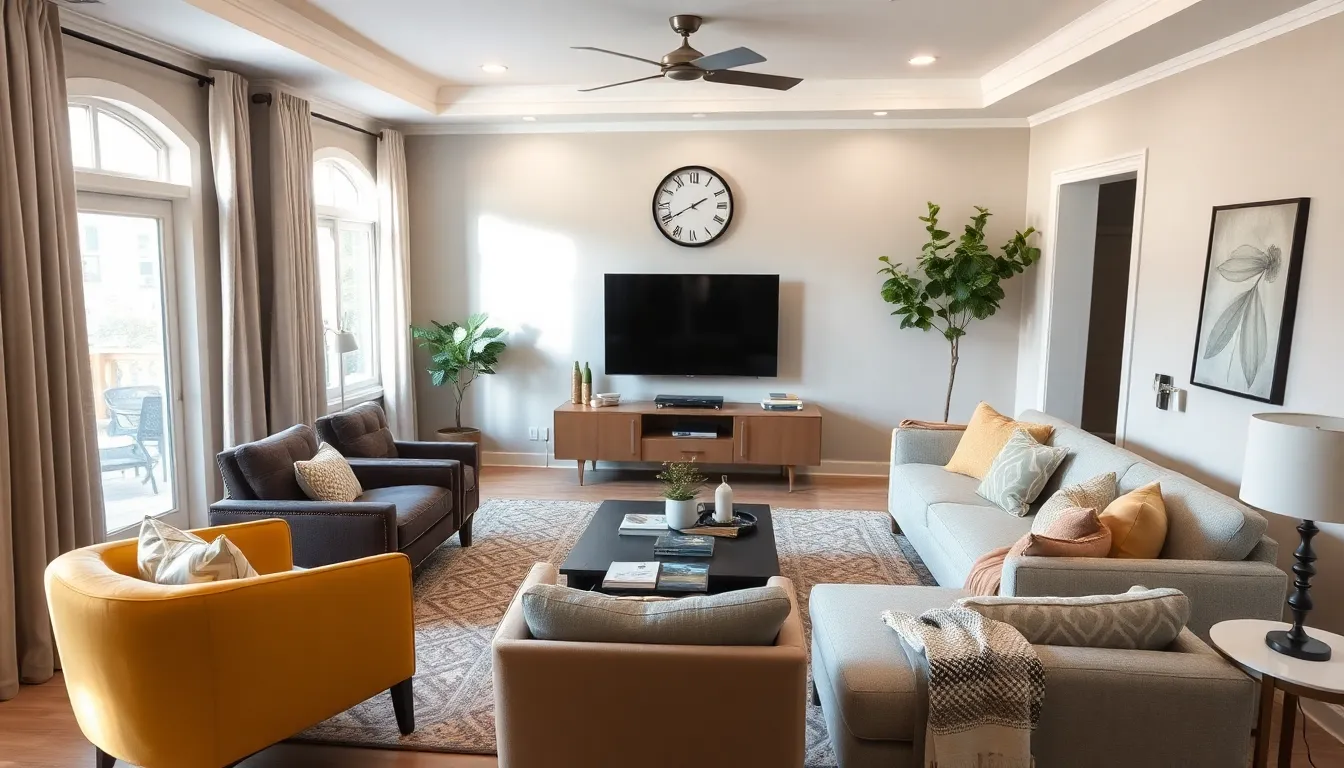
Creating an entertainment-focused layout transforms your living room into the ultimate gathering space for movie nights and binge-watching sessions. We’ll guide you through strategic positioning and smart design choices that maximize both comfort and functionality.
Position Seating for Optimal TV Viewing
Strategic seating placement ensures everyone enjoys clear sightlines to your entertainment center without neck strain or awkward angles. We recommend arranging furniture in a U-shaped or circular configuration that brings viewers closer together while maintaining optimal viewing distances.
Distance calculations matter significantly for comfort and eye health when positioning your main seating. Following the 1.6 to 2.5 times rule means placing your sofa 8 to 12.5 feet away from a 60-inch TV, while a 75-inch screen works best with seating positioned 10 to 15.6 feet back.
Multiple viewing zones accommodate different preferences by creating primary and secondary seating areas. Place your main sofa directly facing the TV, then add accent chairs at slight angles to maintain conversation flow while preserving screen visibility.
Furniture height considerations prevent blocked views when layering seating options throughout the space. Keep coffee tables and side tables lower than seated eye level, typically under 16 inches, to avoid obstructing anyone’s view of the screen.
Hide Cables and Electronics Stylishly
Cable management systems eliminate visual clutter while maintaining easy access to your devices and connections. We suggest using adhesive cable organizers along baseboards or investing in cable raceways that blend seamlessly with your wall color.
Wall-mounted answers create clean lines by positioning your TV above a floating console with built-in cord management features. This approach keeps cables hidden behind the unit while providing accessible storage for gaming consoles, streaming devices, and sound systems.
Integrated furniture designs offer sophisticated cable concealment through purpose-built entertainment centers with rear cutouts and internal routing channels. Choose pieces with adjustable shelving and ventilation features to accommodate various device sizes while maintaining proper airflow.
Decorative screening techniques transform necessary electronics into design elements using woven baskets, decorative boxes, or custom cabinetry with perforated doors. These answers maintain remote control functionality while concealing unsightly components.
Create Dedicated Media Storage Answers
Media wall installations maximize vertical space while showcasing your entertainment collection in an organized, accessible format. We recommend floor-to-ceiling built-ins with adjustable shelving that accommodates everything from gaming systems to vinyl records.
Storage unit combinations blend open display areas with closed compartments to balance accessibility with visual appeal. Mix floating shelves for frequently used items with closed cabinets for seasonal decorations or backup equipment.
Multi-functional furniture pieces serve double duty by providing both seating and storage capacity for your growing media collection. Ottoman storage benches, lift-top coffee tables, and sectional sofas with built-in compartments maximize space efficiency in compact layouts.
Specialized organization systems keep different media types properly stored and easily retrievable through labeled bins, drawer dividers, and vertical filing answers. Consider dedicated spaces for gaming accessories, streaming device remotes, and seasonal entertainment items like holiday movies or summer outdoor speakers.
Enhance Lighting to Set the Perfect Living Room Mood
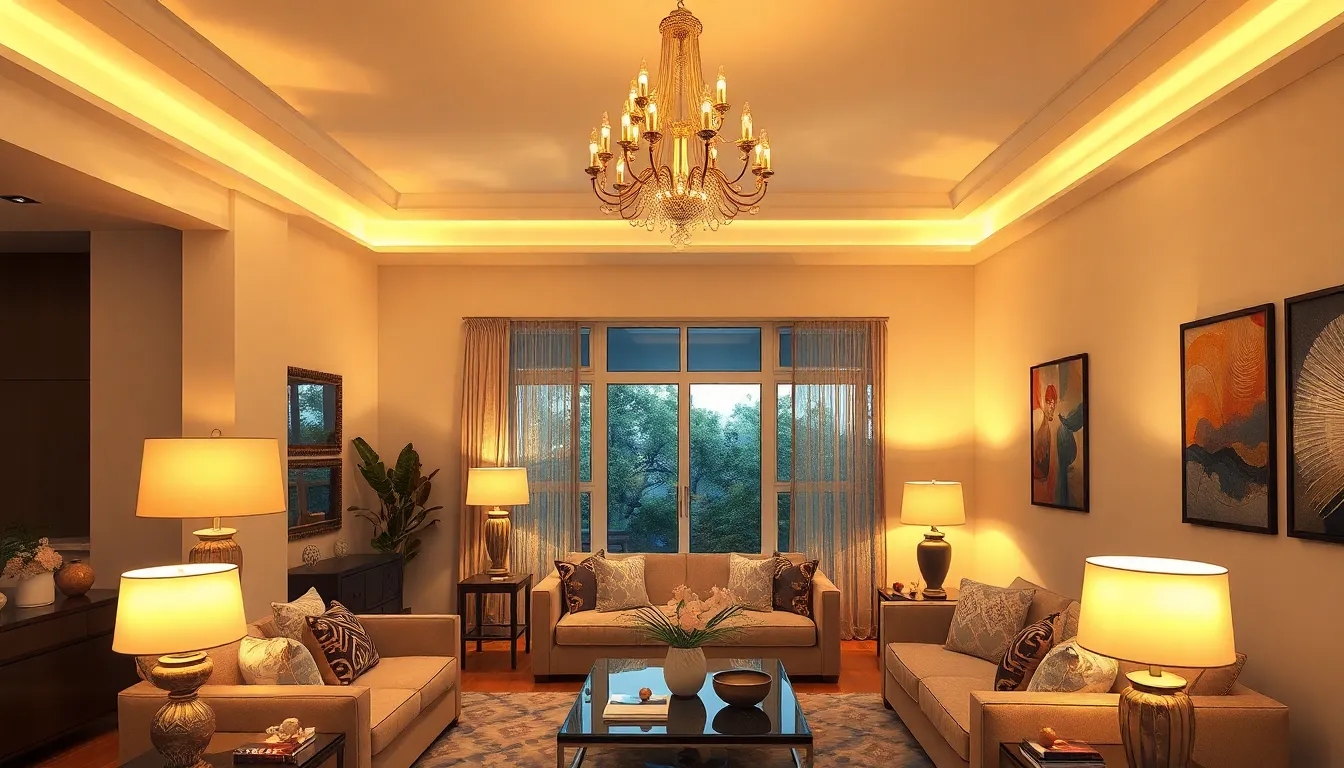
Proper lighting transforms our living rooms from ordinary spaces into ever-changing environments that adapt to every moment of the day. We can create depth and atmosphere by implementing strategic lighting techniques that work together harmoniously.
Layer Different Types of Lighting Sources
Layering multiple lighting sources creates the most effective and flexible illumination system for our living rooms. We achieve this by combining three essential types: ambient lighting provides overall room illumination through ceiling fixtures or recessed lights, task lighting targets exact activities like reading through floor and table lamps, and accent lighting highlights artwork and architectural features using wall sconces or spotlights.
Ambient lighting serves as our foundation, establishing the general brightness level throughout the space. Ceiling-mounted fixtures distribute light evenly across the room, while recessed lighting offers a clean, unobtrusive option that works particularly well in modern designs.
Task lighting focuses on functionality, directing bright illumination exactly where we need it most. Floor lamps positioned beside reading chairs provide excellent task lighting, while adjustable table lamps offer flexibility for various activities. These targeted light sources reduce eye strain and improve our comfort during focused tasks.
Accent lighting adds drama and visual interest by emphasizing exact elements in our room. Picture lights showcase artwork effectively, wall sconces create warm pools of light along walls, and strategically placed spotlights can highlight plants or decorative objects.
Install Dimmer Switches for Ambiance Control
Dimmer switches provide precise control over brightness levels, allowing us to adapt our living room’s atmosphere throughout different times of day and activities. Installing dimmers enables us to transform the same space from bright and energetic during daytime gatherings to soft and relaxing for evening conversations.
We can adjust lighting intensity to match our current needs without switching between different fixtures. Morning coffee might require full brightness to energize our day, while evening movie watching benefits from dimmed ambient lighting that reduces screen glare. This flexibility enhances both comfort and mood by giving us complete control over our environment’s brightness.
Dimmer technology works with most existing fixtures, making it a cost-effective upgrade that delivers immediate results. We notice improved comfort levels as our eyes adjust naturally to changing light conditions throughout the day.
Use Statement Light Fixtures as Focal Points
Statement light fixtures serve dual purposes by providing functional illumination while acting as striking centerpieces in our living rooms. We can select bold chandeliers, sculptural pendants, or artistic lamps that complement our existing décor while becoming conversation pieces that tie together our room’s overall aesthetic.
Chandeliers work exceptionally well in living rooms with higher ceilings, creating elegant focal points that draw the eye upward and make spaces feel larger. Modern chandelier designs range from minimalist geometric shapes to dramatic crystal arrangements that suit various design styles.
Sculptural pendants offer contemporary alternatives that work well above seating areas or coffee tables. These fixtures combine artistic form with practical function, casting interesting shadow patterns while providing targeted illumination.
Artistic table and floor lamps can serve as statement pieces without requiring ceiling installation. We can choose unique shapes, materials, or colors that complement our furniture while adding personality to corners or side tables.
Additional considerations include cord management through decorative conduits or tactile tassels that maintain clean aesthetics, and coordinating our lighting elements with existing room colors and textures for cohesive visual impact. Smart bulbs enhance our flexibility further by offering adjustable color temperature and remote control capabilities.
Choose Color Schemes That Reflect Your Personal Style
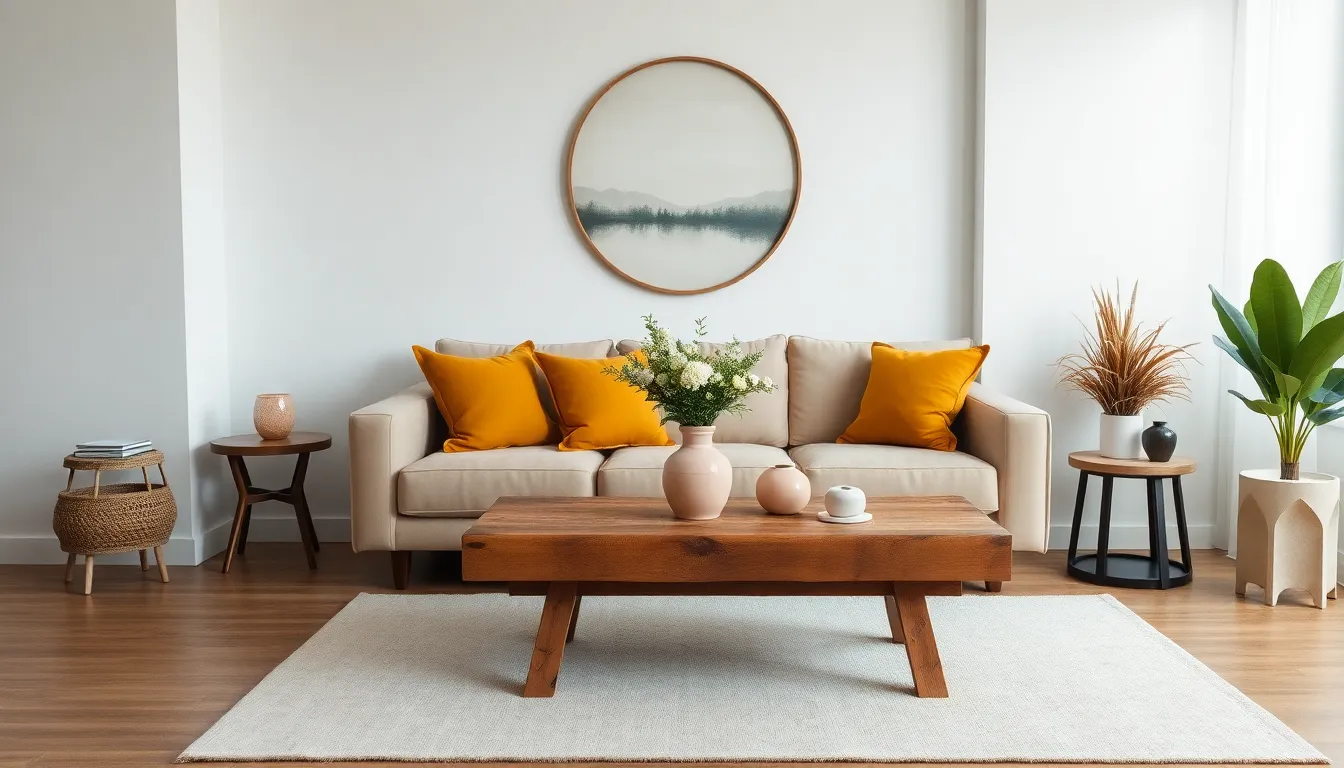
Color selection forms the foundation of any successful living room design. We’ll explore strategic approaches that help you create a cohesive palette reflecting your unique taste.
Work with Neutral Base Colors
Neutrals create versatile backdrops that accommodate changing design preferences over time. We recommend starting with white, gray, or beige as your primary foundation colors since these shades provide flexibility for future decor updates.
Classic black and white combinations add sophisticated contrast to living spaces. This timeless pairing allows for dramatic pops of color while maintaining visual balance throughout the room.
Brown wood tones complement neutral walls beautifully. These natural elements ground your color scheme and create warmth without overwhelming the space.
Add Pops of Color Through Accessories
Colorful upholstery transforms neutral foundations into vibrant living spaces. We suggest incorporating marigold yellow or blue through throw pillows, curtains, and accent chairs to add freshness and playfulness to your room.
Subtle jewel tones offer sophisticated color introduction without dominating the space. Barely there ruby and subdued sapphire work exceptionally well when paired with crisp white walls and natural wood elements.
Dusty pink accents create cozy cottage atmospheres. These soft hues work particularly well in floral patterns and textile accessories for those embracing cottagecore aesthetics.
Warm high contrast schemes energize modern living rooms. Black, charcoal gray, and crisp white provide edgy foundations, while cognac leather and exposed brick add necessary warmth.
Consider Seasonal Color Updates
Seasonal adjustments keep living rooms feeling fresh throughout the year. We recommend swapping throw pillows, rugs, and other accessories to reflect current trends or seasonal moods without major renovations.
Soft purples with gray or blue undertones provide luxurious touches during transitional seasons. These sophisticated hues work well in both spring and fall color schemes.
Accessories offer the most cost effective way to update color schemes seasonally. Small changes in textiles and decorative objects can completely transform your living room’s atmosphere while maintaining your core neutral foundation.
Arrange Furniture for Better Flow and Conversation

Building on our foundation of lighting and color schemes, strategic furniture arrangement transforms your living room into a space that naturally promotes comfort and connection.
Create Multiple Seating Areas
Versatile sofa and chair combinations offer the most flexible foundation for any living room layout. We recommend positioning a sofa with a pair of chairs directly across from it, creating an intimate conversation zone that works beautifully in rooms of all sizes.
Angled chair placement adds visual interest while maintaining functionality. Positioning chairs at slight angles near fireplaces or entertainment centers creates natural focal points that draw people together without forcing rigid seating arrangements.
Two sofas paired with accent chairs deliver both symmetry and abundant seating options. This arrangement works particularly well in larger spaces where you need to accommodate multiple conversations simultaneously while maintaining visual balance throughout the room.
Leave Clear Pathways Throughout the Room
Traffic flow planning ensures guests can move comfortably without handling furniture obstacles. We always maintain clear paths through the room, preventing the frustrating experience of squeezing between pieces or stepping over coffee table legs.
Strategic spacing between furniture pieces creates breathing room that makes your living room feel more spacious. Maintaining at least two feet between chairs, sofas, and coffee tables allows for easy movement while preserving the intimate feel of your seating arrangements.
Wall spacing considerations prevent that cramped, pushed-against-the-wall feeling that makes rooms appear smaller. Pulling furniture away from walls by several inches creates visual depth and allows air to flow around pieces, making your entire space feel more open and inviting.
Position Furniture to Encourage Social Interaction
Face-to-face seating arrangements eliminate the neck strain that comes from awkward conversation angles. We position sofas and chairs so people can easily make eye contact and engage in natural dialogue without twisting or leaning uncomfortably.
Mixed furniture shapes and sizes create visual intrigue while serving practical conversation needs. Combining round ottomans with rectangular sofas and curved accent chairs gives everyone comfortable options while adding design sophistication to your layout.
Focal point furniture placement centers your seating around compelling features like fireplaces or stunning windows. This approach naturally draws people together while giving conversations a beautiful backdrop that enhances the overall ambiance of your living space.
Conclusion
We’ve explored many strategies to help you create the perfect living room that balances style comfort and functionality. From incorporating natural elements and bold accent walls to optimizing lighting and furniture arrangements these ideas offer endless possibilities for transformation.
Remember that the best living room designs reflect your personal style while serving your daily needs. Whether you’re working with a compact space or planning a complete renovation the key lies in thoughtful planning and strategic implementation.
Your living room should evolve with your lifestyle so don’t hesitate to experiment with different elements until you find what works best for your home. Start with one or two changes and build from there – you’ll be amazed at how these thoughtful updates can completely transform your space.
Frequently Asked Questions
What are some budget-friendly ways to refresh my living room?
Focus on small changes with big impact like adding colorful throw pillows, swapping out artwork, updating lighting fixtures, or creating a bold accent wall with paint. Rearranging existing furniture, incorporating plants, and changing seasonal textiles are cost-effective strategies that can transform your space without major renovations.
How do I create a cozy reading nook in my living room?
Choose a quiet corner with natural light away from high-traffic areas. Add comfortable seating like a supportive armchair or window seat, ensure proper lighting with adjustable floor or table lamps, and use sheer curtains to maximize natural light while reducing glare for comfortable reading.
What furniture works best for small living rooms?
Opt for multi-functional pieces like storage ottomans that provide seating and hidden storage. Use floating shelves for vertical storage, choose space-saving sectional sofas, and select furniture that serves dual purposes to maximize functionality while maintaining an open, uncluttered feel in compact spaces.
How can I make a bold accent wall without overwhelming my space?
Try painting one feature wall in trending colors like deep red, navy blue, or classic black. Alternatively, install textured wallpaper or create a gallery wall with personal artwork. Focus on one wall to create a focal point while keeping other walls neutral for balance.
What natural elements should I incorporate into my living room?
Add indoor plants like fiddle leaf figs or snake plants for air purification and color. Use natural materials such as wood furniture, stone or marble accents, bamboo accessories, and linen textiles. These elements promote well-being through biophilic design while creating a warm, sustainable environment.
How should I arrange seating for optimal TV viewing?
Position seating in U-shaped or circular configurations to enhance comfort and sightlines. Calculate proper viewing distance based on your TV size, create multiple viewing zones for different preferences, and ensure all seats have clear views without neck strain for comfortable entertainment experiences.
What lighting types do I need for a well-lit living room?
Layer three types of lighting: ambient lighting for overall brightness, task lighting for specific activities like reading, and accent lighting to highlight artwork or architectural features. Install dimmer switches for customizable ambiance and consider statement fixtures as decorative focal points.
How do I choose the right color scheme for my living room?
Start with neutral base colors like white, gray, or beige for versatility. Add personality through colorful accessories, pillows, and artwork rather than major furniture pieces. Consider seasonal color updates by swapping textiles and decorative objects to refresh your space affordably throughout the year.
What’s the best way to arrange furniture for conversation?
Create multiple seating areas with sofas and chairs positioned to encourage face-to-face interaction. Angle chairs toward each other, maintain clear pathways for movement, and arrange furniture around a focal point like a coffee table or fireplace to naturally draw people together for socializing.

